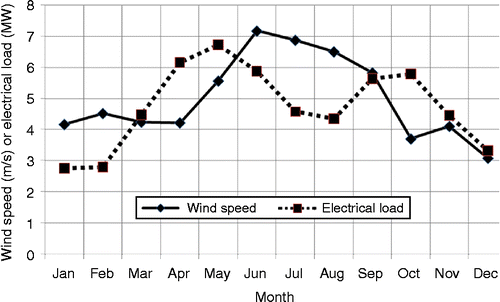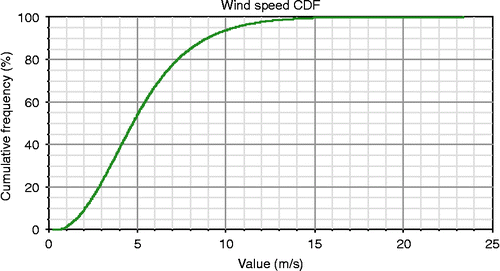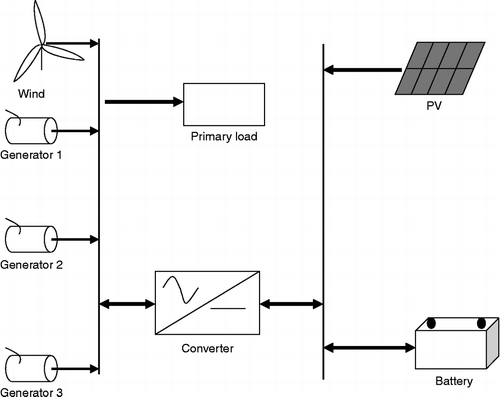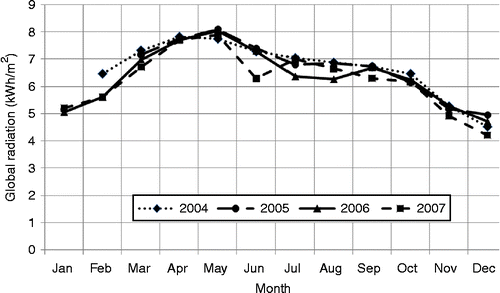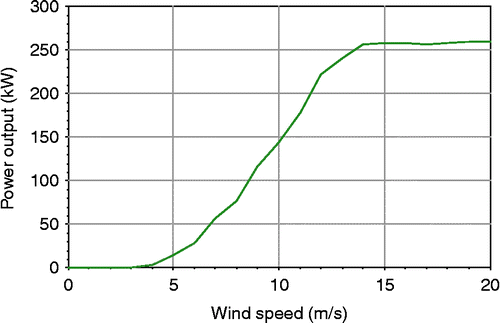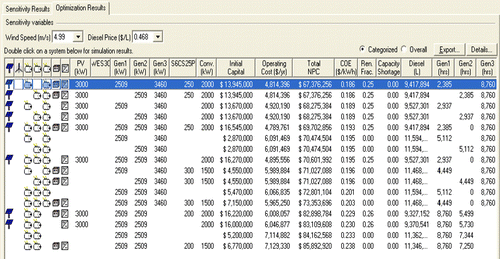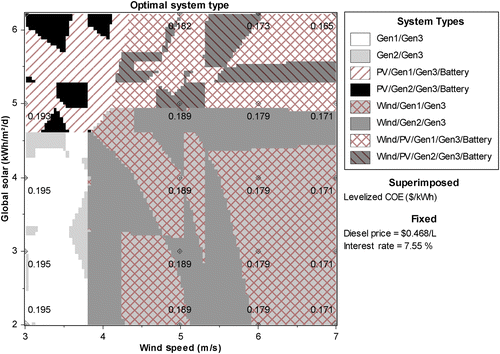Abstract
In this paper, the assessment and modelling of alternative renewable energy systems for Masirah Island is considered. The hybrid system that is simulated comprises various combinations of wind turbines and/or photovoltaic (PV) supplemented with diesel generators and short-term battery storage. It was found from the analysis that the PV–wind–diesel hybrid system, with battery unit, has the lowest cost values as compared to solar-only or wind–diesel hybrid systems. Furthermore, the study illustrates that for a given hybrid system the presence of battery storage will reduce diesel consumption. The decrease in carbon emission, the percentage of fuel savings, the cost of energy production and the effect of wind and PV penetration are also addressed in this paper. The PV–wind–diesel hybrid option is techno-economically viable for the electrification of the Masirah Island.
1. Introduction
The exploitation of renewable energy (RE) resources becomes essential due to the large energy demand worldwide that resulted from the depletion of fossil fuel, fuel price uncertainty, economic development and growing concerns about global warming. Solar and wind energy technologies are the forerunners amongst the different types of RE resources. The total global wind power installed capacity reached 121,000 MW in 2008 (Renewables Global Status Report Citation2010). The production of photovoltaic (PV) solar cells was expected to reach 3.5–3.8 GW in 2007; however, the actual figures exceeded the expectations and reached 6.9 GW in 2008 (Renewables Global Status Report Citation2010).
Grid-connected RE resources have proven to be economically feasible in many places of the world (Khan and Iqbal Citation2009). However, the design of stand-alone hybrid energy resource for use in off-grid locations is yet to reach a commercially viable stage. There are a number of factors that limit RE penetration in an isolated system such as system stability and reactive power and voltage control requirements.
Remote villages in several places in the world (Khan and Iqbal Citation2005, Zoulias and Lymberopoulos Citation2007), and especially in Arabian Peninsula (Shaahid and Elhadidy Citation2008), are powered via diesel generators. Thus, introducing PV and/or wind into the existing diesel system leads to significant reduction in diesel fuel consumption, and ultimately reduces atmospheric pollution. One of the major requirements of a hybrid system is to ensure continuous power flow by storing excess energy produced from RE resources in batteries. In the absence of batteries, the fluctuations in wind turbine power output or PV output are compensated by diesel generators. As a result, the diesel generator runs continuously to cover the difference between RE source and load demand. This means that the generator will run sometimes under light load conditions. The diesel generator's efficiency drops massively when it operates at less than 40% of the full load (Shaahid et al. Citation2007). Moreover, stopping the diesel generator during the period of high winds results in high start–stop cycling frequency, which might lead to wear of the diesel system, and hence increased maintenance cost. Furthermore, a system without batteries should maintain enough spinning reserve to cover wind power drop and/or sudden increase in load demand. Therefore, incorporation of a battery storage system could result in the following:
| • | reduced cost of energy per kWh; | ||||
| • | compensation for the fluctuations in power output of wind turbine; | ||||
| • | reduced excess energy generated; | ||||
| • | reduced generator emissions; | ||||
| • | improved fuel efficiency of the generators; | ||||
| • | increased service life of the generators; and | ||||
| • | decreased run time of diesel generators. | ||||
A hybrid wind and/or PV–diesel system (with and without battery) is a proven technology for electric energy supply to remote places far from the grid (Shrestha and Goel Citation1998, Anindita et al. Citation2009, Khan and Iqbal Citation2009, Al-Badi Citation2011a, Citation2011b, Al-Badi et al. Citation2011, CitationAl-Badi and Bourdoucen in press, CitationAl-Badi et al. in press)
In this paper, feasibility analysis of the RE options for Masirah Island is presented. The wind speed data (Ministry of Transport and Communications; Directorate General of Civil Aviation and Meteorology Citation2009) that cover the period from 1997 to 2008 and the solar insolation level from 2004 till 2007 at Masirah have been analysed to assess the technical and economic feasibility of utilising an isolated hybrid wind and/or PV–diesel–battery power system for the electrification of this Island. This is performed for an annual electrical energy demand of 32,572,840 kWh (minimum load of 200 kW and maximum load of 7500 kW) for the year 2008 (Rural Areas Electricity Company, Oman Citation2009). The average wind speed for 12 years at 10-m height is 4.99 m/s and the yearly average daily value of solar radiation is 6.4 kWh/m2. Since both wind and PV are promising systems in this location, the hybrid system considered in the analysis consists of the following different combinations: wind–PV–diesel with and without batteries, wind–diesel with and without batteries, PV–diesel with and without batteries. The economic solution has been identified for each combination that would meet the load requirement.
National Renewable Energy Laboratory's (NREL) Hybrid Optimization Model for Electric Renewables (CitationHOMER; version 2.68) has been used to perform the feasibility analysis of hybrid PV–wind–diesel generators. Analysis with HOMER requires information on resources, control methods, energy storage medium and economic constraints. Sensitivity analysis could be done with variables having a range of values instead of one number, which allows one to see the effects of change in a certain parameter on overall system performance. Along with the wind speed and solar radiation data, diesel price is also considered as a sensitivity variable.
2. Site information and renewable energy projects
Masirah is the Oman's largest island located at about 15 km from the coast of Al Wusta in Central Oman. It is 95-km-long North–South, between 12 and 14 km wide, with an area of about 649 km2 and a population estimated to 12,000 scattered in 12 villages that are mainly concentrated in the north of the island.
The strategy in Oman to harness RE resources covers three main streams: the first is developing a policy to promote applications of RE, the second is the implementation of a number of projects to improve learning and the third stream consists of building local capacity to have a sustainable business model (Al-Mahrouqi Citation2011). The Authority for Electricity Regulation, Oman (Citation2010, http://www.aeoroman.org/) has confirmed a shortlist of six RE pilot projects where four of them are solar projects. These are: (1) 100-kW PV solar project in Hij, (2) 292-kW solar project in Al Mazyonah, (3) 1500-kW project at location to be confirmed, (4) 28-kW solar project in Al Mathfa incorporating battery storage capability, (5) 500-kW wind project in Masirah Island, and (6) 4200-kW wind project in Saih Al Khairat, Wilyiat of Thumrait. Furthermore, a 200-MW solar power plant is expected to become available in 2014 (Oman Power and Procurement Citation2009).
3. Wind data and dispatch strategy of hybrid system
The long-term monthly average wind speeds (period 1997–2008) for Masirah Island and electrical load are presented in Figure (Ministry of Transport and Communications; Directorate General of Civil Aviation and Meteorology Citation2009, Rural Areas Electricity Company, Oman Citation2009). As can be seen from the figure, the measured wind speed happens to be quite high when the electrical load requirement is also high. Moreover, wind speeds are generally higher during the months of April to September compared to other months. This indicates that the wind turbine would produce substantially more energy during these months compared to other months. Moreover, the figure shows that there is a noticeable variation monthly in average wind speed from one month to another the, which will also vary the monthly energy output of the turbine. These data are measured at a height of 10 m from the ground level. With an increase in height from 10 to 31 m (using 1/7th power law) above the ground level, the wind speed increases by about 17.5%. The calculation of wind energy is made by matching the power–wind speed characteristics of commercial wind turbines with hourly hub-height wind speed data. The wind duration analysis indicates that the wind speeds are less than 3 m/s for about 20% of the time during the year (as shown in Figure ). This implies that a stand-alone wind turbine installed at the island will not produce any energy for about 20% of the time, and hence cannot meet the load demand on a continuous basis.
4. Data input
The proposed hybrid energy system for Masirah Island is presented in Figure . The system comprises a wind turbine, PV array system, battery, converter and diesel generators. The operation of the hybrid system is such that in normal operation the wind turbine and the PV system feed the electrical load demand and all available RE resources will be used to meet the load requirement. The excess energy will be stored in the battery until full capacity of the battery is reached. The energy from the battery will be taken to avoid brining of any new diesel generator to meet short-term increase in the load that exceeds the already existing online diesel capacity and the RE resources. Moreover, in case the output from the wind turbine and the PV system exceeds the load requirements and the batteries’ state of charge reaches its maximum, then the excess energy will be dissipated in a dump load. As a result, the integration of the wind–PV with the diesel systems supplemented with short-term battery storage can meet the required load distribution on a 24-hour basis.
The diesel system is operated only at times when the turbine power and the batteries’ energy fail to satisfy the load demand.
4.1 Diesel generators
The technical and cost information of diesel generators available on site is presented in Table A1 in Appendix 1. This information is provided by the Rural Areas Electricity Company, Oman. It should be mentioned that these generators are derated to take into account the effect of site temperature and humidity. The average lifetime for these generators ranges from 20 to 25 years. The actual diesel price for Masirah Island is 0.468 US$/L.
4.2 Photovoltaic array system
The monthly average daily solar radiation for the period 2004–2007 is depicted in Figure . The insolation level is high during the high electrical load season (April–June) is compared to other months. The yearly average daily value of solar radiation is 6.4 kWh/m2.
PV technology types or area sizes are not required for the model. However, a standard cost of 3000 US$/kW of PV power produced was used with an operation and maintenance (O&M) cost of 10 US$/year/kW (PV prices to drop in half by 2010). The derating factor to compensate for efficiency reduction due to temperature, dust and wiring loses was taken as 0.9. The maximum power point tracking was taken as a standard installation.
4.3 Batteries and converter
The initial cost for the converter was chosen to be 900 US$/kW and O&M of 0 US$/kW, with a lifetime of 15 years and efficiency of 90% (Retail Price List: Inverters 2008, http://www.bergey.com/, Ecodirect Citation2010). The battery capacity was chosen from batteries specified in HOMER. The technical information for the battery is presented in Table A2 in Appendix 1.
4.4 Wind turbine
A 250-kW turbine was considered with a hub height of 31 m. The characteristics of 250-kW wind turbine considered in this study are shown in Table A2. The power curve of the commercially Wind Energy Solutions (WES) 250-kW wind turbine is presented in Figure .
5. Results and discussions
The measured annual average electric power consumption for Masirah Island is depicted in Figure (Rural Areas Electricity Company, Oman Citation2009). Fortunately, the load appears to peak during the period from April to June. The current load requirements of the island are provided by a system of diesel generators.
The proposed hybrid system considered in this analysis consists of different combinations of 250-kW commercial wind turbines and PV panels supplemented with battery banks and diesel generators. The diesel generators are generally sized to meet the peak demand of the power which is around 7500 kW for the year 2008.
Several simulations for various scenarios have been made by considering different PV and wind turbine capacities with and without battery storage systems. The battery storage system chosen is 0–28 minutes of average load. The considered system in the analysis consists of a number of different combinations such as wind–PV–diesel with and without batteries, wind–diesel with and without batteries, PV–diesel with and without batteries. The economic solution was identified for each combination that would meet the load requirements.
5.1 PV–diesel hybrid system
The simulation results for an actual diesel price of 0.468 US$/L are presented in Figure . The level of RE penetration is 25%, which is within the recommended value deployed around the world (Hamsic et al. Citation2007, Basso Citation2008). It should be stated that there are several factors that limit RE penetration in isolated grids. These factors are summarised as follows:
| a. | Spinning reserve.
| ||||
| b. | Minimum loading of conventional generators, as some kinds of diesel generators cannot operate satisfactorily when loaded at less than 40% of their nominal ratings. | ||||
| c. | Step-load requirements, which might be defined as the generator's ability to accept a sudden increase in the load without frequency falling below some preset value. For diesel generators, the step load capability is about 50–75% of the remaining power. | ||||
| d. | Power system stability and oscillations, which are common for some renewable sources such as solar power and wind power to operate at fixed output power. In such a case, the output power is independent of system frequency, so the source does not contribute to system stability. Thus, as RE penetration increases, the amount of energy from conventional generators connected to the system decreases and hence system stability decreases. | ||||
| e. | Reactive power requirement and voltage control: usually a power system operates at a lagging power factor, which means that inductive reactive power should be provided by generators. As the penetration of RE increases, few conventional generators will be required to provide the system's needs of reactive power and voltage control. | ||||
The cost of energy (COE) is 0.186 US$/kWh with 28 minutes battery system. Although the initial capital cost of this hybrid system (3.0-MW PV, 8.478-MW diesel) without the battery unit is lower, the cost of energy increases to 0.189 US$/kWh and the annual diesel consumption will increase by 1%.
5.2 Wind–diesel hybrid system
With 25% RE penetration, the COE for wind–diesel hybrid system (5.25-MW wind, 8.478-MW diesel) is 0.189 US$/kWh with 28 minutes battery system. The simulations show that the cost of energy will reduce to 0.187 US$/kWh with no battery system used.
5.3 PV–wind hybrid system
With this hybrid system (2.25-MW wind, 1.6-MW PV, 8.478-MW diesel) and keeping the same percentage (25%) for RE penetration, the COE is 0.182 US$/kWh with the presence of 28 minutes battery unit. Simulations show that the COE increases to 0.185 US$/kWh if the battery unit is removed from the hybrid system. The percentage of fuel saving in this hybrid system is more than 25% compared to the diesel-only condition. Furthermore, the percentage decrease in carbon emissions by using the PV–wind–diesel system has been found to be 20% the compared to diesel-only situation.
Therefore, using PV–wind–diesel hybrid system with a battery unit will produce the lowest COE compared to PV–diesel hybrid or wind–diesel hybrid with battery.
6. Sensitivity results
Four sensitivity variables (wind speed, solar radiation, diesel price and interest rate) are considered in this analysis. To find the suitable system type and configuration, the search space is widened by introducing various alternatives as shown in Table A3.
For each of the sensitivity values, the computation tool simulates all the system components in their particular search space. A feasible system is defined as a hybrid system that is capable of meeting the load requirements. All infeasible combinations are eliminated and the simulator ranks the feasible systems according to increasing net present cost (NPC).
A total of 240 sensitivity cases (product of wind speed (4), global solar radiation (5), diesel price (3) and interest rate (4)) were examined with each of the system configurations.
Three scenarios for the sensitivity analysis were considered. Typical results for the optimum system type are presented in Figure in terms of wind speed and solar radiation data. Considering the actual diesel price (0.468 US$/L) and the current interest rate (7.55%), a wind–PV–diesel–battery hybrid system is the best for Masirah Island. The total NPC, capital cost and COE for such a system is US$65,895,036, US$13,507,000 and 0.182 US$/kWh, respectively. For a region with very low wind, a PV–diesel–battery system might be suitable. Although the NPC and the capital cost are lower for such a system, the COE is higher (0.185 US$/kWh). Moreover, for the regions with low solar radiation, a wind–diesel system is appropriate with the COE of 0.189 US$/kWh.
The second scenario considered is based on a rise in diesel cost to 0.568 US$/L, the result is that the associated costs with hybrid systems also increase. The second scenario represents a situation when the interest rate is increased to 9%. Although the NPC is reduced (US$59,770,888), however, the COE is increased (0.187 US$/kWh).
7. Conclusions
The paper demonstrates that Masirah Island has got very attractive weather conditions that promote the use of economical RE systems. It has a yearly average daily global solar radiation intensity of 6.4 kWh/m2 and wind speed average of more than 5 m/s for about five months. Therefore, Masirah Island is a prospective candidate for the deployment of PV–wind hybrid system together with the existing diesel station for power generation. The simulation results indicate that for a hybrid system composed of 2.25-MW wind, 1.6-MW PV and existing 8.478-MW diesel with the presence of 28 minutes battery unit (equivalent to 28 minutes of average load) the COE has been found to be 0.182 US$/kWh with the actual diesel price of 0.468 US$/L. The percentage of fuel saving in this hybrid system is more than 25% compared to the diesel system. Furthermore, the percentage decrease in carbon emissions by using the PV–wind–diesel system is 20% compared to the diesel-only situation. This system results in a minimum COE compared with wind–diesel or PV–diesel hybrid system jointly with a battery unit. The percentage of RE penetration for this system is 25%. It has been found that for a given hybrid system, the decrease in diesel runtime is further enhanced by the insertion of battery storage unit.
Acknowledgements
We would like to acknowledge the quality support of the Rural Areas Electricity Company, Oman, for providing all field data on load profiles and diesel generators. The acknowledgement is also extended to the Directorate General of Civil Aviation and Meteorology, Department of Meteorology, for providing the wind and solar radiation data for the site.
References
- Al-Badi , A.H. 2011a . Hybrid (solar and wind) energy system for Al Hallaniyat Island electrification . Journal of Sustainable Energy , 30 ( 4 ) : 212 – 222 .
- Al-Badi , A.H. 2011b . Wind power potential in Oman . International Journal of Sustainable Energy , 30 ( 2 ) : 110 – 118 .
- Al-Badi , A.H. , Al-Badi , M.H. , Al-Lawati , A.M. and Malik , A.S. 2011 . Economic perspective for PV electricity in Oman . Energy , 36 ( 1 ) : 226 – 232 .
- Al-Badi , A.H. , AL-Toobi , M. , AL-Harthy , S. , Al-Hosni , Z. and AL-Harthy , A. in press . Hybrid systems for decentralized power generation in Oman . International Journal of Sustainable Energy ,
- Al-Badi , A.H. and Bourdoucen , H. in press . Study and design of hybrid diesel–wind stand-alone system for remote area in Oman . International Journal of Sustainable Energy ,
- Al-Mahrouqi, M., 2011. Renewable energies resources – challenges and opportunities. In: International conference on harnessing technology, 13–14 February 2011, Oman
- Anindita , R. , Shireesh , B. and Santanu , B. 2009 . Application of design space methodology for optimum sizing of wind–battery systems . Applied Energy , 86 ( 12 ) : 2690 – 2703 .
- Authority for Electricity Regulation Oman, 2010
- Basso, S., 2008. High-penetration, grid-connected photovoltaic technology codes and standards. In: 33rd IEEE photovoltaic specialists conference, 11–16 May 2008, San Diego, CA
- Directorate General of Civil Aviation and Meteorology, 2009
- Ecodirect, 2010. Power inverters–Dc to AC [online]. Available from: http://www.ecodirect.com/solar-Inverters-s/2.htm [Accessed April 2010]
- Gonzálezl , A. , McKeogh , E. and Gallachoir , B. 2003 . The role of hydrogen in high wind energy penetration electricity systems: the Irish case . Renewable Energy , 28 ( 4 ) : 471 – 489 .
- Hamsic, N., Schmelter, A., Mohd, A., Ortjohann, E., Schultze, E., Tuckey, A., and Zimmermann, J., 2007. Increasing renewable energy penetration in isolated grids using a flywheel energy storage system. In: International conference on power engineering, energy and electrical drives (POWERENG), April 2007, Portugal
- Hybrid Optimization Model for Electric Renewables, Available from: http://www.nrel.gov/international/tools/HOMER/homer.html [Accessed July 2010]
- Khan , M.J. and Iqbal , M.T. 2005 . Pre-feasibility study of stand-alone hybrid energy systems for applications in Newfoundland . Renewable Energy , 30 ( 6 ) : 835 – 854 .
- Khan , M.J. and Iqbal , M.T. 2009 . Analysis of a small wind–hydrogen stand-alone hybrid energy system . Applied Energy , 86 ( 11 ) : 2429 – 2442 .
- Oman Power and Procurement, 7-Year Statement (2010–2016), December 2009
- Photovoltaic Prices to Drop in Half by 2010? [online] Available from: http://www.futurepundit.com/archives/004899.html
- Renewables Global Status Report, 2010. September 2010 [online]. Available from: http://www.ren21.net [Accessed April 2011]
- Rural Areas Electricity Company, Oman, 2009. Available from: http://www.reefiah.com/ [Accessed July 2009]
- Shaahid , S.M. , El-Amin , I. , Rehman , S. , Al-Shehri , A. , Ahmad , F. and Bakashwain , J. 2007 . Dissemination of off-grid hybrid wind–diesel–battery power systems for electrification of isolated settlements of hot regions . International Journal of Sustainable Energy , 26 ( 2 ) : 91 – 105 .
- Shaahid , S.M. and Elhadidy , M.A. 2008 . Economic analysis of hybrid photovoltaic–diesel–battery power systems for residential loads in hot regions – a step to clean future . Renewable and Sustainable Energy Reviews , 12 ( 2 ) : 488 – 503 .
- Shrestha , G.B. and Goel , L. 1998 . A study on optimal sizing of stand-alone photovoltaic stations . IEEE Trans Energy Coners , 13 ( 4 ) : 373 – 378 .
- TekVal Int'l Inc., 1730 Leechburg rd., Pittsburgh, PA, 15235, USA [online]. Available from: http://www.tekval.org
- Zoulias , E.I. and Lymberopoulos , N. 2007 . Techno-economic analysis of the integration of hydrogen energy technologies in renewable energy-based stand-alone power systems . Renewable Energy , 32 ( 4 ) : 680 – 696 .
